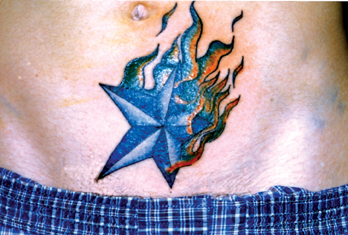Other stories on Culture & Leisure: |
Tattoo or taboo?
Body art no longer an underground culture

By Karen Tong
The rap music’s deep bass line shook the room while Michael Chan, owner of Hong Kong Tat-too, punctured a large tattoo onto his customer’s back. The rapper, 50 cent, was turned up full blast.
Kaz Chan, 36, who co-runs the shop with twin brother Michael, has been a tattoo artist for 10 years.
Over the years, he has seen an increase in the number of young customers.
He attributes the increase to influence by tattooed celebrities such as pop singers and basketball players.
Candy Lo, Faye Wong, Nicholas Tse and David Beckham are some of the celebrities who wear tattoos.
Said Mr. Chan: “Teenagers and young adults are usually more sensitive about fashion trends and are willing to try something new.”
Deejay Long, a 17-year-old college student, said, “Allen Iverson has over 20 tattoos on his body, and many of them carry a special meaning.
“I really admire the praying hands on his arm. They are so beautiful that I am considering getting some tattoos.”
Mr. Chan advises that prospective customers should not copy others’ tattoos.
Said he: “Tattoos are supposed to be unique. It’d be better if we each had our own creations and ideas.
“I’d say that customers are more independent now, in that they want to be special and have their own style.
“It is less likely that they’ll just follow exactly what their idols or others have.
“They have their own ideas and know what they want to have marked on their bodies.”
Mr. Chan said that customers are now more creative and serious about getting tattoos, because more customers bring along their own designs.
“It is good if a tattoo carries meaning.
“A disabled Canadian girl once asked for a tattoo of a world map on her left shoulder.
“She couldn’t walk, so she put her feelings and wish to travel into her tattoo.”
According to Tiffany Chan, owner and operator of Boom Studio, tattooing is no longer confined to a certain age group or social background.
“I’ve had different kinds of customers over the past few years, such as doctors, office ladies, housewives and students.
“My youngest customer was a 13-year-old boy. He already had two tattoos before he came to me, and now he has at least 10.
“I was surprised at the number of tattoos he had at such young age.
“He has tattoos on his arms, lower abdomen, lower back, shoulders – almost everywhere.
“Nowadays, tattoos are more accepted by society. It has become a part of popular culture and fashion, which attracts a lot of people.”
In ancient times, tattooing was less about vanity or fashion.
Greek spies used tattoos to identify themselves, and the Japanese marked lines and arches on criminals’ foreheads.
According to The Tattoo History: A Source Book, there is archeological proof that puncture marks on human bodies originated in ancient Egypt.
Female clay figurines marked with diamond-shapes, dots and dashes, dating back to 4000 B.C., were discovered in Egyptian tombs.
They are believed to be the earliest tattoos.
One of the best-preserved mummies dates to the Egyptian XI Dynasty, from 2160 to 1994 B.C.
The mummy of Amunet, a priestess of the goddess Hathor at Thebes, an ancient city of upper Egypt, showed several body markings.
The mummy bears curved lines and patterns around its navel and has parallel lines tattooed on its arms.
Tattoo designs during that time were rather simple compared with the designs available now.
Today, there are over 30 categories of tattoo styles, including portraits, Celtic designs, cartoons, and religious and tribal symbols.
Tattoos can either be in a single color, usually black, or in multi-colors, usually a maximum of three colors for a single tattoo.
Puncturing of tattoos take between 10 minutes for a simple design to several hours over multiple sessions for more complicated designs.
The price of a tattoo varies according to its design, size and color.
At Boom Studio, Ms. Chan said that a simple 1-inch Chinese character costs $400.
A multi-colored dragon covering the whole back could cost up to $10,000.
If a person decides to remove a tattoo, laser surgery is the best option.
However, it does not come cheap.
“Removing a palm-sized tattoo costs around $100,000,” said Mr. Chan of Hong Kong Tattoo.
Eric Ma, associate professor in the School of Journalism and Communication at The Chinese University of Hong Kong, is researching cultural identities.
Said he: “Tattooing is no longer an underground culture. It used to be popular among prostitutes and triads such as Sun Yee On and 14K.
“It is more common in other social groups nowadays.”
Prof. Ma said that people now have a stronger desire to manipulate their bodies and appearance.
“We have more accessible channels to ‘reconstruct’ ourselves – aerobics, aroma therapy and yoga.
“Tattooing is one of the ways that allow people to change their bodies.”
Tattooing has thus emerged from its objectionable past to gain increasing popularity.
The National Geographic News reported in April 2000 that 15 percent of Americans have tattoos.
Statistics for Hong Kong were not available.
However, Prof. Ma said tattooed people are generally not accepted in the Chinese society.
“The Chinese believe that preserving our bodies is respectful to our parents.
“Tattooing contravenes this traditional belief.
“The stigma of tattoos still exists, and thus encourages or discourages people from getting tattoos.
“Going against society evokes excitement. Yet to a certain extent, tattoos symbolize rebellion and impropriety.”
However, there are legal restrictions. According to the Tattooing of Young Persons Ordinance, it is “. . . an offence to tattoo any person under the age of 18 years . . . .”
First offenders will be fined $1,000. Repeat offenders can be fined $5,000 and sent to prison for 3 months.